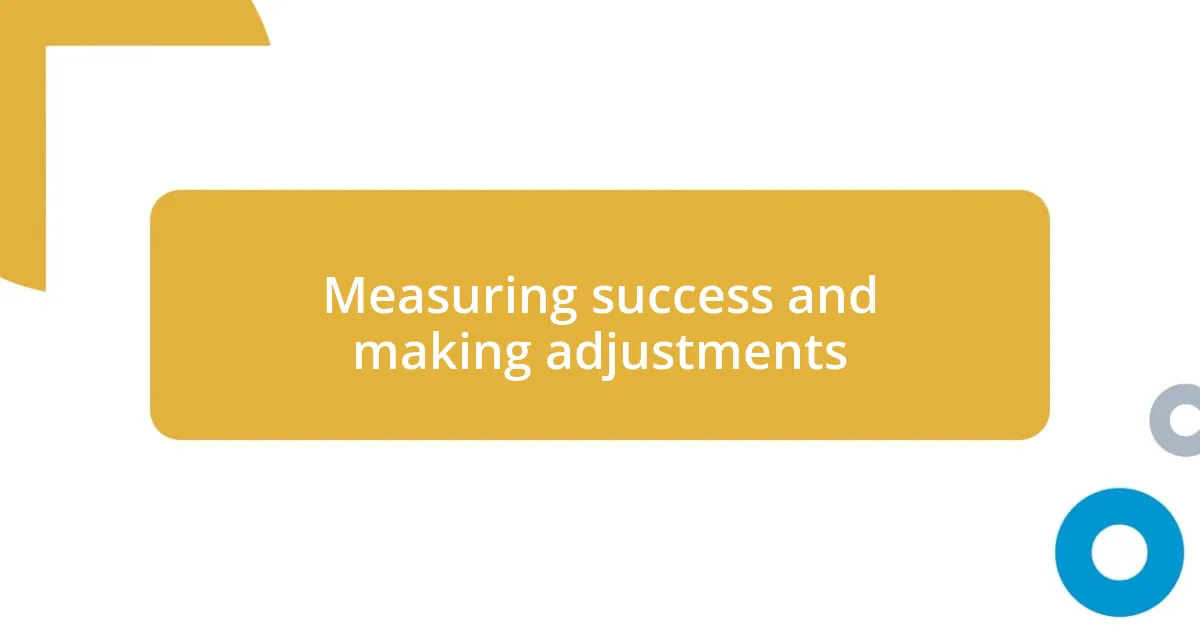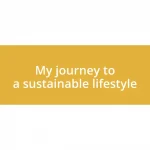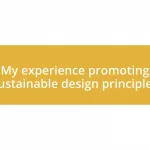Key takeaways:
- Embracing a zero-waste philosophy involves understanding the “5 R’s”: Refuse, Reduce, Reuse, Recycle, and Rot, which guide sustainable choices in the workspace.
- Involving the team through initiatives like “Sustainable Challenge” and “Zero Waste Fridays” fosters camaraderie and shared commitment to reducing waste.
- Tracking progress and making adjustments, such as organizing a “jar swap,” helps adapt strategies to encourage ongoing participation and success in waste reduction efforts.

Introduction to zero-waste workspace
I’m excited to share my experiences in creating a zero-waste workspace. It’s not just a trend; it’s about redefining how we interact with materials and resources in our work environments. When I first started this journey, I was surprised to discover just how much waste I was generating without even realizing it.
Imagine looking around your office and seeing items that were once new, now becoming part of a disposable culture. I remember feeling a twinge of guilt as I opened the bin, overflowing with plastic wrappers and crumpled paper. What if we could transform that guilt into a positive force for change? By embracing a zero-waste philosophy, we can take small, meaningful steps that make a huge difference, both for ourselves and for our planet.
Thinking about it, how often do we consider the lifecycle of the products we use daily? I began scrutinizing everything from my pens to my post-it notes, propelled by the desire to create not just a tidy desk but one that’s truly sustainable. This journey has been both enlightening and fulfilling, reminding me that every little choice counts in the larger narrative of environmental responsibility.

Understanding zero-waste principles
Zero-waste principles center around the idea of minimizing waste by rethinking how we use resources. When I started this journey, I was struck by the importance of the “5 R’s”: Refuse, Reduce, Reuse, Recycle, and Rot. Refusing single-use items was the most challenging for me—like when I found myself reaching for a plastic coffee cup during my morning rush. Each time I opt for my reusable cup, I feel a little victory.
In applying these principles to my workspace, I realized that awareness is key. I began keeping a waste diary to track what I was throwing away. Surprisingly, it wasn’t just food wrappers; there were countless things I could swap out or eliminate completely. For example, shifting from paper appointments to a digital calendar not only streamlined my work but also cut down on paper waste.
On a practical level, understanding zero-waste means committing to a mindset shift. I learned that straightforward choices, like packing my lunch in reusable containers instead of plastic bags, could accumulate significant changes over time. It’s more than just cleaning out a space; it’s about making conscious decisions every step of the way.
| Principle | Description |
|---|---|
| Refuse | Saying no to single-use and unnecessary items. |
| Reduce | Cutting down on what you consume. |
| Reuse | Finding new ways to use items before discarding them. |
| Recycle | Processing materials to make new products. |
| Rot | Composting organic waste to return nutrients to the earth. |

Assessing current waste practices
I started my journey by closely examining my workspace waste practices. To be honest, I didn’t realize how much I was throwing away daily until I took the time to reflect. Each coffee break led to at least one paper cup making its way into the bin—an easy habit to fall into, right? I began jotting down what I was tossing out each day, and the results were eye-opening.
Here’s a look at the common waste practices I discovered during my assessment:
- Single-use items: Plastic cutlery, paper cups, and straws were all too common.
- Excessive packaging: Many supplies I ordered arrived heavily packaged, often in materials I couldn’t recycle easily.
- Unnecessary paperwork: I noticed I was printing emails and documents that could just as easily be accessed digitally.
- Food waste: Leftover lunches that never made it to the fridge often ended up in the trash.
As I addressed these practices, I felt a mix of empowerment and sadness. Empowerment came from taking control of my habits, while sadness stemmed from a growing awareness of the larger waste issues affecting our planet. I realized that recognizing these patterns was just the first step; each decision moving forward could spark a change.

Choosing sustainable office supplies
When I began revamping my office supplies, I was amazed at how many eco-friendly options exist. It wasn’t just about swapping out items; it was a revelation. For example, I discovered brands that provide recycled paper, which not only feels great to write on but also reduced my environmental footprint. Could something as simple as changing your notebook make a difference? Absolutely—you’re nurturing the planet with every page you fill.
Looking at pens and markers, I realized traditional options come with a lot of waste—think plastic casings and ink cartridges. I switched to refillable pens that have a much longer lifespan than their disposable counterparts. It felt like a small victory every time I refilled my pen instead of tossing it. Have you ever thought about how many pens you go through in a year? When I calculated it for myself, the number shocked me.
Choosing sustainable office supplies also opened my eyes to the joy of supporting local businesses and artisans. I remember feeling a warm sense of fulfillment when I purchased handcrafted desk organizers made from reclaimed wood. Not only did they add a rustic charm to my workspace, but supporting a small business felt like contributing to a larger positive change. These small, sustainable choices not only help the environment but also create a workspace that reflects my values. Isn’t it satisfying to see your personal ideals manifest in your surroundings?

Implementing recycling and composting
Implementing a proper recycling and composting system was one of the most impactful changes I made in my workspace. I clearly remember the moment I set up labeled bins for recycling paper products, plastics, and compost. It felt like a small but mighty step towards a more conscientious routine. At first, there was a bit of confusion, especially regarding what could really go in each bin. I found it helpful to create a quick reference guide that I taped beside the bins. This way, my colleagues and I were always in the loop, and slowly, our habits shifted.
Composting was initially intimidating for me. I didn’t want to mess it up and create odors or attract pests. To tackle my fears, I started small with a countertop compost bin that I emptied into a larger outdoor bin. Watching food scraps transform into rich soil was like witnessing a miracle! It made me appreciate the lifecycle of food in a whole new way. Honestly, it turned what I saw as waste into a resource, and it reinforced my desire to minimize food waste on my plate, too. Have you ever considered how much potential is left in your food scraps?
The positive impact of recycling and composting really flourished when my coworkers got involved. A little friendly competition emerged as we tried to outdo each other in reducing waste. This camaraderie has been a delightful and unexpected bonus! People would share their tips, and soon, our lunchtime discussions revolved around how to compost their vegetable peels or upcycle old office items. I realized that when I shared my experiences openly, I not only encouraged others but also strengthened our commitment to a zero-waste workspace. Have you experienced a similar bonding moment with your team around sustainability? It’s truly rewarding.

Encouraging team involvement
I found that getting my team involved in the zero-waste journey was essential for long-term success. One day, I proposed a “Sustainable Challenge” where we set a weekly goal to reduce our waste. The excitement in the room was palpable! Seeing my colleagues begin to brainstorm creative ideas was energizing. We transformed our routine into a game, which sparked laughter and innovation. Who would have thought waste reduction could turn into such a team-building exercise?
I remember a colleague coming to me with a brilliant suggestion of using glass jars instead of plastic containers for lunch storage. It turned into a mini-revolution! Everyone started sharing their own finds—like compostable wrap and reusable straws—and soon it felt like we were crafting a kind of eco-friendly exchange program. Isn’t it wonderful how a simple idea can bloom into a community-focused initiative? This collective enthusiasm not only lightened the workload but deepened our connections.
Moreover, I made it a point to celebrate our victories, no matter how small. I initiated “Zero Waste Fridays,” where we all showcased our waste-reduction wins over coffee. It felt rewarding to highlight our achievements and create a safe space for discussing challenges. Witnessing the team’s pride as they shared their stories of change was nothing short of inspiring. Have you ever felt that surge of motivation when surrounded by like-minded individuals? I certainly did, and it reaffirmed that together, we could create a workspace that resonated with our shared commitment to the environment.

Measuring success and making adjustments
Measuring the success of my zero-waste initiatives wasn’t just a numbers game; it was also about the tangible shifts in our daily habits. I recall setting a goal to reduce office waste by 25% over a quarter, and we meticulously tracked our progress through weekly check-ins. Each small victory, like noticing fewer trash bags on collection day, brought a rush of excitement and validation. It was like seeing our collective efforts blossom, reinforcing that we were on the right path. Don’t you love those moments when you realize your hard work is paying off?
As we progressed, it became clear that some strategies needed tweaking. For instance, while the glass jars for lunch storage were a hit, we quickly discovered that not everyone had them readily available. In response, I organized a fun “jar swap” event, encouraging team members to share extras or even thrift their own. This not only solved the problem but also fostered a spirit of collaboration. How often do we stumble upon unexpected solutions when we invite feedback?
Adjustments also meant being open about our challenges. I remember one meeting where we candidly discussed composting mishaps, like an entire bag of mixed food waste getting tossed mistakenly. Rather than feeling defeated, we turned it into a learning moment, sharing tips on proper compost layering. The energy in the room shifted from frustration to determination, and I realized that transparency was just as crucial in our journey as celebrating our wins. Isn’t it empowering to transform setbacks into stepping stones? That’s how we kept evolving toward our zero-waste workspace vision.













